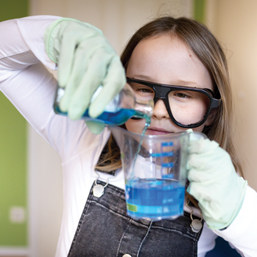
Whether you’re a seasoned homeschooler or this is new territory and you plan on homeschooling your kids for the first time, you may struggle to find a balance between work (learning) and leisure (play) for your students. Your plan may be to schedule your kids’ days with time slots focused on academics, followed by breaks during which your kids can engage in less-structured activities.
What if I told you that work and leisure time don’t have to be separate? What if there was a way to structure much of the school day so that learning and play are so intertwined that your students won’t be able to distinguish between the two? As a mother and as a teacher, I have found that when you tap into your children’s intrinsic motivation to learn through play, academic goals are achieved more naturally.
Let’s get specific about play (I’m not talking about hopscotch and board games here). I’m talking about a different kind of play, with infinite possibilities for both learning and engagement: STEM play! Through this type of play, children learn about the concepts of Science, Technology, Engineering, and Math often through highly-engaging, hands-on activities. STEM play can help your children develop essential life skills like problem-solving, creativity, thinking outside the box, resilience, collaboration, and independent work ethic. Play and learning can go hand in hand with the result being academic success. Added bonus? Kids love to play!
As a homeschooler, do you provide opportunities for your children to engage in STEM play? If not, it’s never too late to start! Here are five easy ways to get your kids engaged in STEM activities. The best part? You don’t have to be a science whiz to play with your kids or scaffold their learning. I’ve included the basics here, as well as some ways you can prompt your children’s curiosity while they play:
1. Candy diffusion. Arrange a hard-shell candy (like Skittles) in a circle around the inside edge of a plate. Pour a small amount of warm water onto the middle of the plate (just enough to make a thin layer and reach the candies) and then wait! As the sugar-colored coating dissolves in the added water, the colors spread out, making a fun-looking swirly rainbow on the plate. Ask your kids questions while they watch and play: “Where is the color coming from? Do you see patterns? What would happen if you added cold water instead of warm water, and why does this happen?”
2. Oobleck. Combine one cup of water with food coloring in a baking dish or container, then add two cups of cornstarch. Combine and play! Ask your kids: “What happens when you squeeze the substance? Release it? How does it feel?” Oobleck is a suspension of starch in water, not a full solution. Its ability to transform between solid and liquid is mesmerizing for children - and adults!
3. Pom-pom launcher. Tie the end of a deflated balloon and cut about an inch off the other end. Stretch the open balloon around the end of a paper tube (wrapping or toilet paper). Secure with strong tape (packing tape works well). Place a pom-pom inside the tube and then pull back on the balloon knot. The balloon now holds elastic potential energy! Release the balloon to create kinetic energy and watch the pom-pom fly! Make it more fun by creating shooting targets so your kids can practice their aim!
4. Lava lamp. Fill a plastic bottle one-third full of water and the rest with oil. Drop food coloring on top and wait for it to sink to the bottom. Add half of an Alka-Seltzer tablet and observe. Ask your kids, “Why does the oil sit on top of the water? What’s making the bubbles? Why does the oil float up and down?” Oil floats on top of water because it is less dense. The Alka-Seltzer reacts with the water to make CO2 bubbles, which attach themselves to the blobs of colored water and carry them to the top of the glass. When the bubbles pop, the blobs of colored water fall back to the bottom. Keep adding seltzer for more entertainment!
5. Giant bubbles. Dissolve half a cup of cornstarch into six cups of water. Add 1 Tbsp. of baking powder, half a cup of Dawn dish soap, and 1 Tbsp. of glycerin. Mix and let rest for one to two hours. Then use giant bubble wands (available to purchase at department stores or online). My family loves playing with bubbles for hours of entertainment outside on a warm day. Prompt your children by asking, “Why are bubbles round? Why do they pop? Do bubbles have colors?” Basically, a bubble is air wrapped in soap film, but you can get more specific and talk to your kids about topics like surface tension, light, and elasticity!
Remember, Google is your friend if you don’t have the answers and for ideas on weekly activities for your kids, follow me on Instagram.
Ashley Frampton is a mom of three, Early Childhood Educator, and Elementary Teacher. She has a Master’s Degree (Instructional Leadership) from the University of Calgary and loves inspiring families, educators, and caregivers to help their children learn at home and school. For more ideas, follow her on Facebook, and Instagram.
Calgary’s Child Magazine © 2024 Calgary’s Child